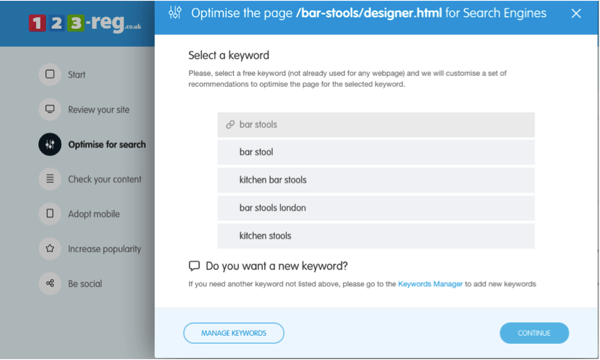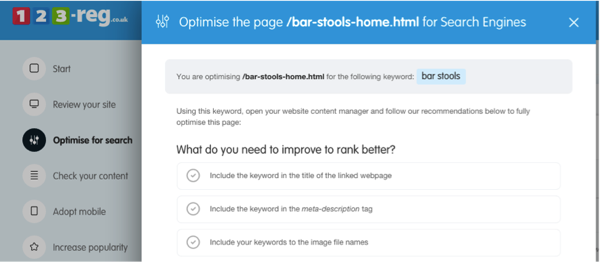How to optimise a landing page for search engines
Landing page optimisation is big business, and not just for successful pay-per-click (PPC) campaigns but also for longer term projects that generate leads and sales. So if your landing pages aren’t doing a good job at turning visitors into paying customers and you don’t know how to fix the problem, read on.
In this post we’ll show you how to optimise a landing page correctly to make it as likely as possible that visitors who land on it after having clicked a PPC ad, a Facebook ad, or a link in the search engine results end up buying from you.
The essentials
Let’s start with the key elements of a good landing page. All these elements need to be in play, and missing even one will undoubtedly impact your sales.
- Clear and concise headline that acts as a hook and grabs the attention of the visitor.
- Great visuals that reinforce your unique value proposition and draw people further in.
- Benefit-oriented content that tells people how your product is going to solve their problem.
- Scannable content that makes it easy for visitors to understand your offering.
- Call to action that tells visitors what they should do next.
- Social proof in the form of customer testimonials or social media accounts that can help validate your brand or product.
Watch our Swift Six video to learn more about the vital elements of a winning landing page.
How to optimise your landing page
While search engine optimisation (SEO) isn’t a major factor for short term marketing campaigns, such as PPC or Facebook ad campaigns, it is critical for any landing page on your site that will be live for any extended period of time. This means that you need to care about SEO and ensure the content is optimised for maximum value.
So, here is what you need to optimise your landing pages correctly for search engines:
Compelling title tag
The meta title or title tag is vital to an effectively optimised page. It’s probably the most important title you’ll write. Each landing page needs to have a unique title tag that’s not just keyword focused but also compelling enough for users to choose to click your link over the ten others on the first page.
While anyone can throw keywords in a title to get ranked, it takes practice to create a title that will get more click than the competition. Check out this great resource from Moz.com on headline writing and title tag SEO in a clickbait world.
Catchy description
The meta description may not be very important for rankings, but it’s a vital SEO component. That’s because it appears in the search engine results and it’s what can get visitors to click on your link and visit your landing page.
Use the meta description to make an enticing offer while also including a strong call-to-action that tells the searcher your page has what they’re looking for. The goal here is to make your description more compelling that those of your competitors so that it generates clicks.
Read this post to learn how to write a meta description that gets clicks.
Keyword-focused headline
The headline is the first thing visitors see after landing on your page from the search engine results. Make sure you add your main keyword to the headline and set it as H1 for proper optimisation. H1, also known as the header tag, is still an essential on-page SEO element that is used to tell search engines as well as users what a page of content is about.
An optimised H1 tag reassures users that they’ve come to the right place and that they’ll find the information you promised they’ll find when clicking your link.
Apart from a strong headline, you should also use subheadings to break up the content on your page and to summarise each content area. This will make it easier for users to go through all the information about your product or service.
Content that focuses on benefits
The content on your landing page needs to be relevant and consistent with the expectations your user had at the time they clicked the link. It also needs to be clear and to the point so that the visitor can understand right away what’s in it for them, how their lives will be bettered or how their problems will be fixed.
While you should never stuff your content with keywords, make sure you keep your content focused on a small group of keyword phrases in order to build up the topical page authority needed to rank in search engine results.
Scannable content
As you probably know by now, few people read an entire page of text online. So if you have a landing page with lots of content, make is easily scannable. That means including subheadings and bullet points to give visitors a quick way to go through all the information on that page and move to the one that matters most to them.
In addition, get rid of any extra content or design elements that might clutter the page and distract visitors from completing your goals. If you want to turn more visitors into paying customers, don’t chase them away with a chaotic page. Instead, keep it clean and appealing with as few distractions as possible.
Social signals
Make it simple for your visitors to share your landing pages if they want to. An optimised landing page needs to be set up to be socially shared as easily as possible. This lets your visitors share your pages if they want to, which can drive more traffic to your site. So, why not let them do the heavy lifting for you? They’ll not only spread the word about your business but they might also send other potential customers to your site.
Call to action
A landing page without a call to action is useless. Every page on your site needs to have a goal that you want to achieve. A strong call to action helps you achieve that goal by telling visitors what they should do next. Be their guide, don’t just drop people on your page and abandon them to figure it out for themselves.
Watch our Swift Six video to learn how to create the strongest possible call to action and ensure that most visitors that land on your site eventually become customers.
Keep improving
The only way to increase rankings and conversions is to test your landing pages and see what works and what could use some tweaking.
The Search Engine Optimiser tool from 123-reg will show you exactly which pages on your site need to be optimised and what you need to improve. For example, you might discover that your page isn’t keyword-focused. So now all you need to do is to select a strong keyword from the list.
Next, just follow a few recommendations to fully optimise your page:
There are many different elements to landing page optimisation and having access to a tool like this allows you to make improvements that can help increase traffic and sales.
Your turn now
What else are you doing to optimise your landing pages for search engines?


